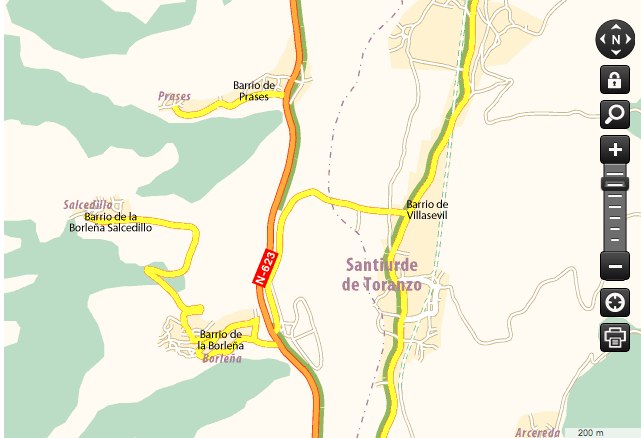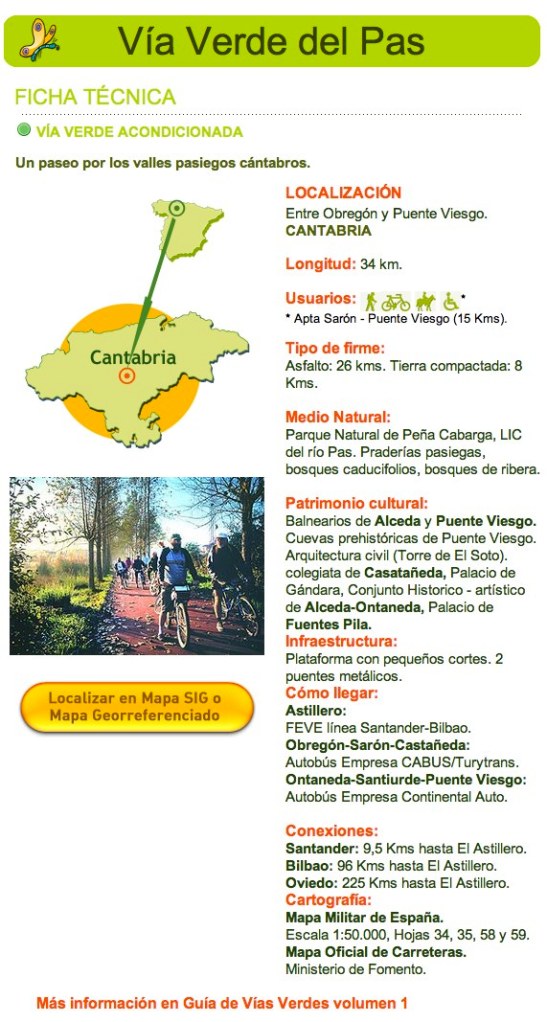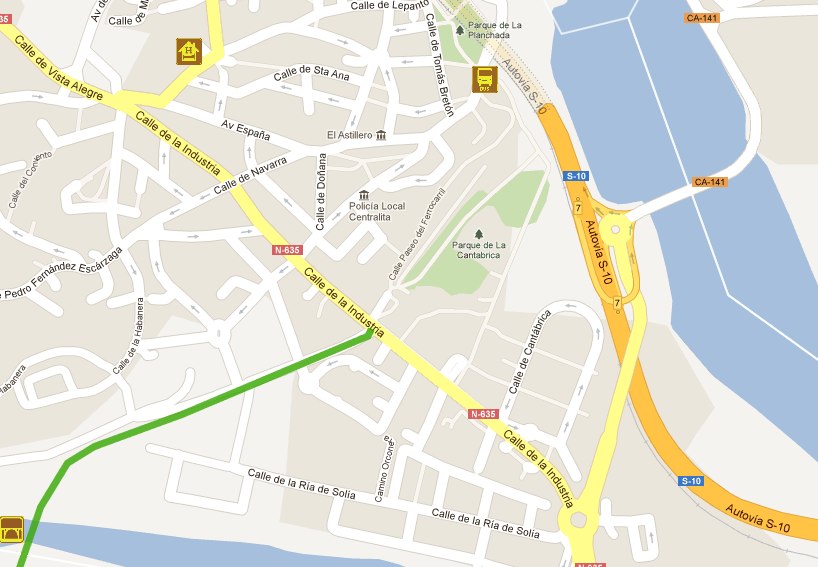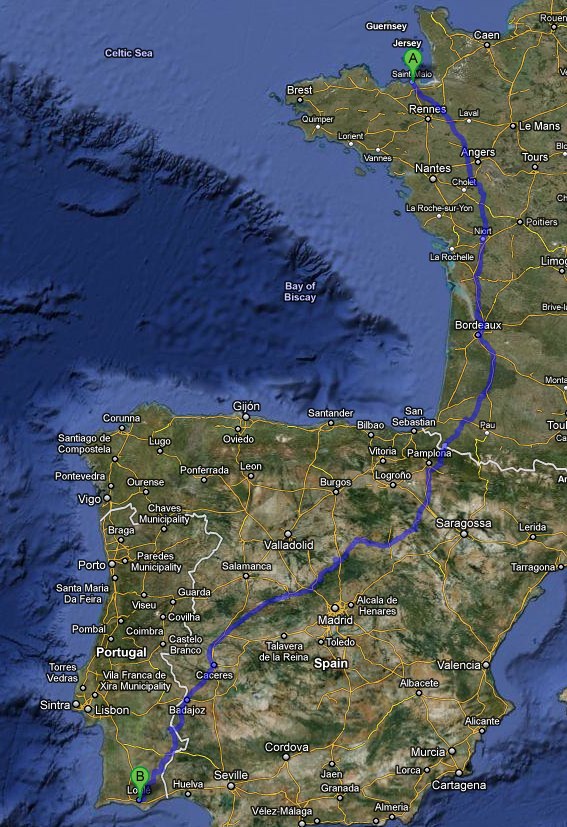This is Brittany Ferries suggested route out from Santander along the coast to the West then South into the Picos de Europa. Sounds good!
Picos and coastal cycle route details
Approximately 235 miles (total climb 15,000 feet).
A delightful but challenging route that runs a few miles inland of the coast to the west of Santander then climbs into the national park of the Picos de Europa.
The Picos stand at over 8000 feet high and three of our mountain passes are more than 1 mile above sea level. Highlights include the medieval village of Santillana del Mar, and the deep-sided gorges that lead into the Picos. Wildlife is in abundance, and if camping, you will be lulled into sleep by the sound of cowbells.
If the steep hills of the Picos are not for you, these can be missed. From Panes the route can be extended further west to take in more dramatic coastal towns and sandy beaches.
Santander to Unquera
Approximately 44 miles.
Leaving Santander is not a problem but you will need to follow the suggested route carefully. The coastal route (CA231 N611 & CA131) west of Santander to Unquera, is ideal for cyclists and is fairly low in traffic once away from Santander. This route is part of the Camino de Santiago de Compostella pilgrims’ route so you will meet many walkers on the way. If you have time or maybe fancy a dip at one of the numerous beaches, take some of the back roads off to the right to get closer to the sea. These roads have a poorer surface and are hillier than the main road but you are certainly off the beaten track here. There are plenty of options for food, hotels and campsites along the way.
The first major town, Santillana del Mar is a tourist honey pot and it’s easy to see why. This former medieval capital of Asturias has it all – cobbled streets, ancient stone houses and artisans’ shops clustered around many town squares and courtyards. It really comes alive in the cool of evening when coach loads of Spanish tourists descend. (Tourist Information Office, hotels and campsite.)
The campsite in Comillas, 10 miles west of Santillana, has an enviable position, right on the cliff top.
Approaching St Vicente de Barquera the views of the town and estuary are stunning.
It’s a pleasant town with a medieval tourist trail. Look out for the castle, an old bridge and the church which has an unusual floor made of wooden coffins. Best to be rich if buried here, as you will have prime position near the altar.
We leave the coastal road at Unquera, a town with many facilities and head south towards the Picos.
Unquera to Potes
Approximately 26 miles (total climb 1,900 feet).
The road from Unquera to Panes, the gateway to the Picos, runs along the edge of the Sierra de Cuera mountains. Our route takes us into the foothills of these mountains, through green rolling hills and the odd eucalyptus forest. For a slightly shorter, flatter but less interesting and busier route, take the N621. In Panes there are hotels but no campsite.
If the hills of the Picos are not for you, in Panes turn off onto the AS114 towards Cangas de Onis , then return towards the coast and Caravia.
From Panes there is a 15 mile steady and easy climb up a valley and the Hermida gorge. The direction of the road means it is often in full sun, which may be a problem early afternoon.
Potes, at 1,000ft is a charming town with a medieval heart, old bridges, twisting cobbled alleys and overhanging houses. There are plenty of hotels and the nearest campsite is 1mile up a hill outside the town.
If you have time for a day off from touring, cycle up to Fuente De (14 miles and 2,500 feet climb) to take the cable car to the Mirador del Cable.
Potes to Posada de Valdeón / campsite at Santa Marina
Approximately 36 miles (total climb 5,700 feet).
Today is the challenging day. There are very few hotels between Potes and Posada so it is not easy to break the journey in two. The 17 miles from Potes to the first pass at San Glorio is a steady, relentless climb of 4,250 feet. At San Glorio, you are a little over 1 mile above sea level. The first 5 miles are fairly easy but you are soon in lowest gear for the remainder, mostly on hairpin bends. There is little shade and the climb is tough, especially in full sun but the magnificent views make it worthwhile. To help you to the top you will get shouts of encouragement and gasps of admiration in equal measure from envious car drivers. There is little by way of food or water so take plenty of supplies.
From San Glorio you descend 1,000 feet alongside a river, following a delightful, wide valley of pastureland full of cows and sheep, all with tinkling bells. After the turn off onto the LE243, the gentle hill becomes steeper until you reach the Puerto de Pandetrave pass, also 1 mile high. Cars are few and far between. You are now in the middle of the Picos and the mountains are at their most dramatic.
Santa Marina de Valdeón is a wonderful, rather crumbly mountain village with nothing much going on. There is one bar/restaurant. The road to the campsite is less than a mile but incredibly steep. Still, it doesn’t stop the old ladies with amazing calf muscles clambering up with their walking sticks.
It’s cooler here in the mountains, especially at night. The campsite has good amenities, a restaurant and shop and you can fall asleep to the sound of cowbells and owls.
Alternatively, continue downhill into Posada de Valdeón where there are many hotels and restaurants. Posada is a small mountain town popular with tourists and walkers.
A spot of walking
From Posada de Valdeón, it’s well worth taking a few hours off for a detour to walk part of the magnificent Cares gorge. The start point for your walk (and finish) is in Caín, a pretty tourist village with a good choice of food and accommodation, north of Posada. You can cycle the 5 or 6 miles from Posada down to Caín but be warned, it’s a 1,500 feet return climb, tough even without luggage. The gorge lies north south so can get very hot mid day. It meanders a bit so some shade is available from time to time.
Posada de Valdeón to Cangas de Onis
Approximately 38 miles (total climb1900 feet).
From Posada, there is an easy seven mile climb which becomes quite bendy through the trees towards the top, the Puerto de Panderruedas at 4,900 feet. After a few miles down and up you reach the Puerto el Pontón. From here, the landscape becomes greener and more importantly, you can put your feet up for an exhilarating 28 mile descent. Adding a couple of layers for warmth may be a good idea at this point.
You pass through a ten-mile stretch of the Desfilladero de Beyos, a spectacular gorge with some unusual, towering rock formations. This gorge marks the western edge of the Picos. There are plenty of food and drink stops but few hotels.
Cangas is a fairly modern, large town with hotels, a tourist office and a campsite a couple of miles to the east.
Cangas de Onis to Llanes
Approximately 26 miles.
Leaving Cangas, you gently ascend the fertile valley of the Río Güeña with the foothills of the Picos to the south. After Benia and the turn off onto the AS115, you enter a long attractive valley, heavily scented with eucalyptus and pine. You may be lucky enough to spot an eagle or two to the left. If you want more of a challenge than this easy downhill stretch you can take a detour through some mountain villages to the east (your right). There are campsites in Soto de Cangas and Benia where you will also find a couple of hotels.
Llanes is a lovely old port with a vibrant market and a good Tourist Office. It is good to spend at least a few hours here so wander the old streets or consider an overnight stop. Plenty of hotels and campsites.








